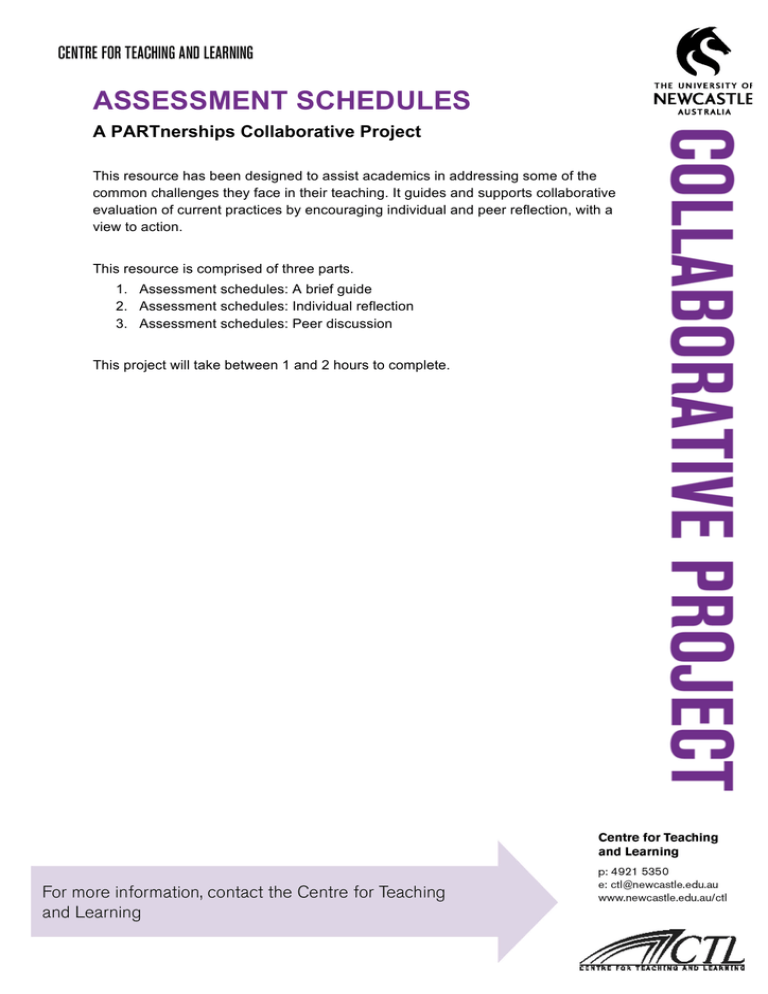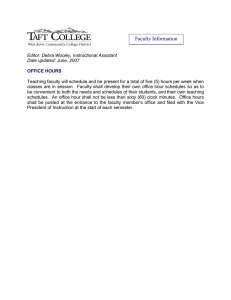assessment schedules - University of Newcastle
advertisement

ASSESSMENT SCHEDULES A PARTnerships Collaborative Project This resource has been designed to assist academics in addressing some of the common challenges they face in their teaching. It guides and supports collaborative evaluation of current practices by encouraging individual and peer reflection, with a view to action. This resource is comprised of three parts. 1. Assessment schedules: A brief guide 2. Assessment schedules: Individual reflection 3. Assessment schedules: Peer discussion This project will take between 1 and 2 hours to complete. Assessment schedules: A brief guide Boud and Associates (2010) claim that assessment is most effective when (among other things) it is used to engage students in learning that is productive, and assessment for learning is placed at the centre of subject and program design. Many options are available to us, which include using academic technologies. A good start is to consider your full assessment schedule. What should I consider when devising an assessment schedule? Assessment activities should be: Well-aligned with If alignment is not present students may be learning what is not learning outcomes assessed, students may be assessed on what they have not and activities learned, and/or students' learning may be assessed inappropriately. Engage students in a Are the types of activities contained within the tasks suitable for suitable activity students to demonstrate, and for you to measure, their achievement of learning outcomes? Set at the right level The difficulty (level and complexity) of the task reflects the entry of difficulty level of the students, and their progression through a program. Weighted Task weighting takes into account the relative importance of aligned appropriately intended learning outcomes, and considers student workload. Timed well Timing affects student workload (within the course, and within the program), provision and use of good quality feedback, and marking considerations. Add variety Students are able to demonstrate a range of skills if given a variety of tasks within and across courses. Repetition of assessment types can restrict important learning development. Cater for diversity Assessment options can allow for students to show understanding in a variety of ways. Scaffolding provides advice for students in completing tasks if they are not familiar with them. Clear Assessment schedules and individual items should be clear and unambiguous. Too much or too little detail can be confusing and result in many student queries. Centre for Teaching and Learning 2 Assessment schedules: Individual reflection Use these tables to reflect on your current assessment schedule (½ − 1 hour). 1 Alignment For each of these principles associated with alignment (below), evaluate your course as it stands, and determine if changes should be made. Principle Comments Course learning outcomes should be measured by assessment tasks. Does your assessment schedule measure every learning outcome wholly or in part? Are some course outcomes being overassessed, and others under-assessed? All graded assessment tasks should be represented by the learning outcomes. Are you assessing students’ skills/knowledge that are not explicitly or implicitly articulated by the course learning outcomes? Assessment tasks should be valid. Will the schedule of tasks measure what they are actually intended to measure? Assessment tasks should be reliable. Will the schedule of tasks produce reliable results within and between cohorts of similar students? Centre for Teaching and Learning 3 2 Other aspects of your assessment schedule Type of Are the types of activities contained Y activity within the tasks suitable for students N Comments to demonstrate, and for you to measure, their achievement of learning outcomes? Mode Can the tasks be Y administered/assessed differently? N Comments For example, could the tasks be completed online? In groups? In parts? Within class? Difficulty Are the level and complexity of the Y tasks suitable for the students in the N Comments course? Consider students’ prior learning and experience, the program as a whole, and the students’ progression through the program. Weighting Does the weighting of the tasks fairly Y reflect their relative roles within the N Comments course and the workload expected of the students? Also consider the University’s assessment policies: do your tasks reflect these? Timing Is the timing of the tasks suitable? Y Can students complete the tasks on time? Is N Comments there time for students to use feedback between tasks? Are other courses expecting submissions at the same time? Variety Is there variety in the set of tasks? Y Can students develop, practice and N Comments demonstrate a range of skills? Is there too much repetition? Diversity Is there a chance that some students Y are unfairly advantaged or N Comments disadvantaged by the tasks? Clarity Are the questions/directions clear Y and unambiguous? N Comments Be careful of giving too little or too much information. Centre for Teaching and Learning 4 Assessment schedules: Peer discussion Use these questions to guide the discussion with your peer reviewer (½ – 1 hour). 1) What did you learn about your assessment schedule from your reflection? 2) How would you rate your assessment schedule with regard to impact on student learning? 3) How would you rate your assessment schedule with regard to workload efficiency? 4) What solutions can your pair identify to strengthen your assessment schedule and address workload efficiencies? 5) Identify up to two strategies you would like to use to implement the changes you have identified. Date for a follow-up meeting to discuss further: __________________________________ Reference Boud, D. & Associates (2010). Assessment 2020: Seven propositions for assessment reform in higher education. Sydney: Australian Learning and Teaching Council. Centre for Teaching and Learning 5
